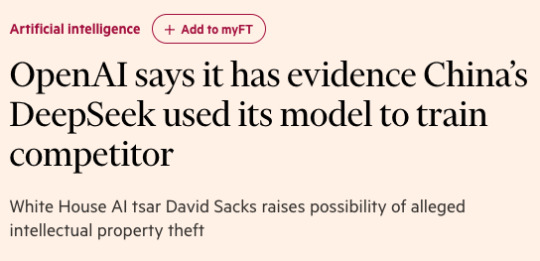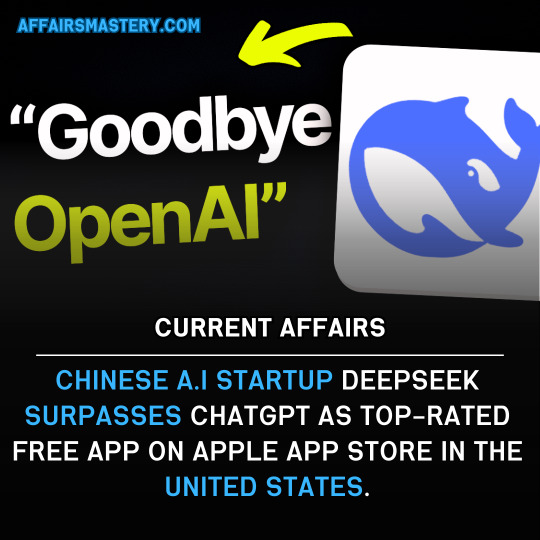#technology news china
Explore tagged Tumblr posts
Text


2K notes
·
View notes
Text
The Rice Revolution: Slashing 70% of Methane Emissions While Boosting Yields https://www.goodnewsnetwork.org/the-rice-revolution-slashing-70-of-methane-emissions-while-boosting-yields/
Scientists in China experimenting with rice cultivars have been able to crossbreed a non-GMO variety that produces 70% less methane, a potent greenhouse gas that is emitted in large amounts through rice cultivation.
#methane#methane emissions#good news#environmentalism#science#environment#rice#china#agriculture#nature#green technology#technology#climate change#climate crisis
82 notes
·
View notes
Text
"Major AI companies are racing to build superintelligent AI — for the benefit of you and me, they say. But did they ever pause to ask whether we actually want that?
Americans, by and large, don’t want it.
That’s the upshot of a new poll shared exclusively with Vox. The poll, commissioned by the think tank AI Policy Institute and conducted by YouGov, surveyed 1,118 Americans from across the age, gender, race, and political spectrums in early September. It reveals that 63 percent of voters say regulation should aim to actively prevent AI superintelligence.
Companies like OpenAI have made it clear that superintelligent AI — a system that is smarter than humans — is exactly what they’re trying to build. They call it artificial general intelligence (AGI) and they take it for granted that AGI should exist. “Our mission,” OpenAI’s website says, “is to ensure that artificial general intelligence benefits all of humanity.”
But there’s a deeply weird and seldom remarked upon fact here: It’s not at all obvious that we should want to create AGI — which, as OpenAI CEO Sam Altman will be the first to tell you, comes with major risks, including the risk that all of humanity gets wiped out. And yet a handful of CEOs have decided, on behalf of everyone else, that AGI should exist.
Now, the only thing that gets discussed in public debate is how to control a hypothetical superhuman intelligence — not whether we actually want it. A premise has been ceded here that arguably never should have been...
Building AGI is a deeply political move. Why aren’t we treating it that way?
...Americans have learned a thing or two from the past decade in tech, and especially from the disastrous consequences of social media. They increasingly distrust tech executives and the idea that tech progress is positive by default. And they’re questioning whether the potential benefits of AGI justify the potential costs of developing it. After all, CEOs like Altman readily proclaim that AGI may well usher in mass unemployment, break the economic system, and change the entire world order. That’s if it doesn’t render us all extinct.
In the new AI Policy Institute/YouGov poll, the "better us [to have and invent it] than China” argument was presented five different ways in five different questions. Strikingly, each time, the majority of respondents rejected the argument. For example, 67 percent of voters said we should restrict how powerful AI models can become, even though that risks making American companies fall behind China. Only 14 percent disagreed.
Naturally, with any poll about a technology that doesn’t yet exist, there’s a bit of a challenge in interpreting the responses. But what a strong majority of the American public seems to be saying here is: just because we’re worried about a foreign power getting ahead, doesn’t mean that it makes sense to unleash upon ourselves a technology we think will severely harm us.
AGI, it turns out, is just not a popular idea in America.
“As we’re asking these poll questions and getting such lopsided results, it’s honestly a little bit surprising to me to see how lopsided it is,” Daniel Colson, the executive director of the AI Policy Institute, told me. “There’s actually quite a large disconnect between a lot of the elite discourse or discourse in the labs and what the American public wants.”
-via Vox, September 19, 2023
#united states#china#ai#artificial intelligence#superintelligence#ai ethics#general ai#computer science#public opinion#science and technology#ai boom#anti ai#international politics#good news#hope
200 notes
·
View notes
Text

Chinese startup DeepSeek's AI Assistant has surged past ChatGPT to become the top-rated free app on Apple’s U.S. App Store. Powered by the advanced DeepSeek-V3 model, praised for rivaling even the most advanced global AI systems, the app's rapid rise is shaking assumptions about U.S. dominance in AI innovation.
Despite U.S. export controls on advanced chips to China, DeepSeek leveraged Nvidia's H800 chips with a reported training cost under $6 million, sparking debates on the effectiveness of these restrictions. Founded in 2023 in Hangzhou, DeepSeek has become the first Chinese AI model to gain significant praise from Silicon Valley for matching, and potentially surpassing, top-tier U.S. AI models.
#general knowledge#affairsmastery#generalknowledge#current events#current news#upscaspirants#upsc#generalknowledgeindia#breaking news#world news#news#technology#geopolitics#usa#united states#united states of america#china#openai#intelligence artificielle#ai technology#artificial intelligence#machine learning#deepseek#ai#chatgpt#nvidia#siliconvalley#banglore#innovation#tech
8 notes
·
View notes
Text

https://thestreet.com/technology/elon-musk-gets-more-bad-china-news…
#bigtroubleinlittlechina as #tariffs hit #tesla. #futures #Economy #BlackMonday #orangemonday #FAFO #Nifty #Sensex #marketcrash #sp500 #teslastock #stockmarket #Tariff #TRUMPUMP #TrumpRecession #TrumpMarketCrash #stock #stocks #friday #cnn #TSLA

#stock market#news#world news#yahoo finance#investing#fox news#breaking news#celebrity news#usa news#government#technology#china#tariffs#tesla cars#tesla cybertruck#tesla#elon musk#musk#elongated muskrat#stock trading#investing stocks#global#us stock market#marketing#artists on tumblr#photographers on tumblr#writers on tumblr#tumblr girls#blog#microblog
4 notes
·
View notes
Text
Alibaba releases AI model allegedly superior to DeepSeek
Chinese technology company Alibaba released a new version of its artificial intelligence (AI) model Qwen 2.5, which it claimed outperformed the sensational DeepSeek-V3, according to Reuters.
The release of the new AI model came on the first day of the Lunar New Year. Alibaba’s cloud unit stated:
Qwen 2.5-Max outperforms … almost across the board GPT-4o, DeepSeek-V3 and Llama-3.1-405B.
The release of AI assistant DeepSeek, powered by DeepSeek-V3, on 10 January and the release of its R1 model on 20 January stunned Silicon Valley and triggered a plunge in tech stocks.
The low-cost startup led investors to question the huge spending plans for top AI companies in the United States. However, DeepSeek’s success also led to a battle among its domestic competitors to update their own AI models.
Two days after the release of DeepSeek-R1, TikTok owner ByteDance released an update to its flagship AI model, which it claimed surpassed the Microsoft-backed OpenAI o1.
The fact that DeepSeek-V2 was open source and unprecedentedly cheap led Alibaba’s cloud division to announce a price cut of up to 97 per cent on the range of models. Other Chinese tech companies followed suit, including Baidu, which launched China’s first ChatGPT analogue in March 2023, and the country’s most valuable internet company, Tencent.
Liang Wenfeng, the mysterious founder of DeepSeek, said last July that his project “did not care” about price wars and that achieving AGI (artificial general intelligence) was its main goal. While large Chinese tech companies such as Alibaba have hundreds of thousands of employees, DeepSeek operates as a research lab staffed mostly by young graduates and doctoral students from leading Chinese universities.
Large foundational models require continued innovation, tech giants’ capabilities have their limits.
Read more HERE

#world news#news#world politics#china#china news#deepseek#deep seek#qwen#ai#artificial intelligence#ai technology#chatgpt#openai#intelligence artificielle
6 notes
·
View notes
Text
How the U.S. is losing ground to China in nuclear fusion, as AI power needs surge
China and the U.S. are in a race to create the first grid-scale nuclear fusion energy. After decades of U.S. leadership, China is catching up by spending twice as much and building projects at record speed. Often called the holy grail of clean energy, nuclear fusion creates four times more energy per kilogram of fuel than traditional nuclear fission and four million times more than burning coal,…
#Alphabet Inc#Artificial intelligence#Bill Gates#Breaking News: Technology#business news#China#Environment#Generative AI#Jeff Bezos#Microsoft Corp#Nuclear power#Sam Altman#Science#Technology#United States#Video First
2 notes
·
View notes
Text
youtube
Another new video from our "AI Evolves" channel. Explore a future where hyper-realistic robots become indistinguishable from humans. Discover how these lifelike companions could change our lives, impact personal relationships, and reshape societal norms. Join us as we delve into the technology behind these robots, their potential roles in our daily lives, and the ethical considerations they raise. Stay up to date by subscribing to our channel. Please subscribe 🙏 / @aievolves
#female humanoid ai robot#elon musk#mass production of female robots will soon make women unnecessary#mass production of female robots#artificial intelligence#robots#ai#robot#future technology#robotics#ai news#humanoid robots#pro robots#technology#humanoid robot#robot news#openai#best ai#future ai#computer science#china robots#world robot conference#ai evolves#rick & morty#machine learning#ai tools#matt wolfe#ai video#tech news#luma ai
3 notes
·
View notes
Text
17 notes
·
View notes
Text
U.S. n-Propyl Acetate Prices, News, Trend, Graph, Chart, Monitor and Forecast
The n-Propyl Acetate market has witnessed dynamic fluctuations in pricing, driven by a combination of supply chain factors, raw material costs, and demand trends across various industries. This solvent, widely used in coatings, adhesives, inks, and personal care products, has experienced varying price movements based on regional market conditions and economic trends. The pricing of n-Propyl Acetate is heavily influenced by feedstock prices, particularly acetic acid and propanol, which are subject to fluctuations due to crude oil price volatility and production rates. Over recent months, global prices have remained relatively stable in some regions while facing downward pressure in others due to weak demand and ample supply. The United States market, for instance, has observed steady pricing, largely due to stable raw material costs and consistent demand from end-use industries such as paints and coatings. The industrial and manufacturing sectors continue to play a significant role in shaping the market landscape, with production levels and trade policies also contributing to price trends. Additionally, supply chain disruptions caused by logistics challenges and geopolitical issues have impacted pricing trends in certain markets.
Get Real time Prices for n-Propyl Acetate : https://www.chemanalyst.com/Pricing-data/n-propyl-acetate-1133
In the Asia-Pacific region, particularly in China and India, n-Propyl Acetate prices have experienced fluctuations due to changes in crude oil prices, demand from downstream industries, and regional economic conditions. The Chinese market has faced moderate price volatility, influenced by fluctuating feedstock costs and varying demand from the industrial and construction sectors. In India, market prices have slightly declined in certain months due to weakened demand from the coatings and printing industries, despite government initiatives aimed at boosting the construction sector. However, the long-term outlook remains positive, with growing industrialization and infrastructure projects driving demand. In Europe, n-Propyl Acetate prices have faced some downward pressure due to weak economic conditions and subdued industrial activity. Energy prices, which have been volatile in the region, have also played a role in determining production costs, impacting overall market pricing.
One of the major factors influencing the global n-Propyl Acetate market is the cost of acetic acid and propanol, the two key raw materials. These feedstocks are directly linked to crude oil prices, making them susceptible to global oil market trends. Any fluctuations in crude oil prices can have a cascading effect on the cost structure of n-Propyl Acetate production. Additionally, the supply and demand balance of these feedstocks can create price volatility, especially during periods of increased production or supply shortages. Market players closely monitor these trends to anticipate future price movements and make strategic purchasing decisions.
The demand for n-Propyl Acetate is strongly linked to its applications in the coatings, adhesives, and personal care industries. The coatings industry, in particular, is a significant consumer of this solvent due to its superior solubility properties. As urbanization and infrastructure development continue to expand, particularly in emerging economies, the demand for coatings and, consequently, n-Propyl Acetate is expected to rise. The adhesive and sealant industry also contributes to the market's growth, with increased applications in packaging and construction. Additionally, the pharmaceutical and cosmetics sectors use n-Propyl Acetate in various formulations, further driving demand. However, economic downturns and slowdowns in construction activities can have an adverse impact on demand, leading to price reductions in some markets.
The global market outlook for n-Propyl Acetate remains positive, with a projected compound annual growth rate (CAGR) driven by industrial expansion and technological advancements. Market analysts anticipate steady growth over the next decade, supported by rising consumption across multiple end-use sectors. The solvent's eco-friendly properties, compared to other volatile organic compounds (VOCs), also contribute to its increasing adoption. Stricter environmental regulations regarding solvent emissions have prompted industries to seek alternatives with lower environmental impact, positioning n-Propyl Acetate as a viable option. Innovations in production processes and supply chain optimization are also expected to play a role in stabilizing prices and ensuring steady market growth.
In North America, market stability has been a key feature, with demand remaining consistent despite economic fluctuations. Manufacturers have maintained steady production levels, ensuring balanced supply and demand dynamics. The U.S. market has benefited from a well-established industrial base and consistent raw material availability, leading to moderate price movements. Additionally, ongoing trade discussions and logistics improvements have helped maintain stable pricing trends. In Latin America, demand for n-Propyl Acetate has been growing, particularly in Brazil and Mexico, where the construction and manufacturing sectors have seen expansion. However, economic uncertainties and currency fluctuations have posed challenges, leading to periodic price variations.
The European market has experienced some softness in pricing due to sluggish industrial growth and concerns over energy costs. The region's focus on sustainability and environmental compliance has influenced the demand for n-Propyl Acetate, with manufacturers exploring greener production methods. While demand remains steady, economic headwinds and regulatory challenges may impact pricing trends in the future. The Middle East and Africa region has shown moderate growth, driven by increasing industrialization and infrastructure projects. With continued investments in the construction and automotive industries, the demand for solvents like n-Propyl Acetate is expected to increase. However, geopolitical instability and supply chain disruptions remain potential risks that could influence market pricing.
The impact of global economic conditions, including inflation, interest rates, and trade policies, also plays a role in shaping the n-Propyl Acetate market. Rising inflation rates can lead to increased production costs, affecting market prices. Similarly, trade restrictions and tariffs on raw materials or finished products can disrupt supply chains, leading to price volatility. Industry players need to stay informed about macroeconomic trends and adjust their strategies accordingly to navigate market uncertainties.
Looking ahead, the n-Propyl Acetate market is expected to experience continued growth, driven by expanding industrial applications and increasing demand for eco-friendly solvents. Market participants should focus on innovation, cost optimization, and strategic sourcing to remain competitive. As new regulations and sustainability initiatives shape the chemical industry, companies that adapt to changing market conditions will be better positioned for long-term success. Monitoring supply chain dynamics, raw material pricing, and demand trends will be crucial for stakeholders looking to capitalize on market opportunities while mitigating risks associated with price fluctuations.
Get Real time Prices for n-Propyl Acetate : https://www.chemanalyst.com/Pricing-data/n-propyl-acetate-1133
Contact Us:
ChemAnalyst
GmbH - S-01, 2.floor, Subbelrather Straße,
15a Cologne, 50823, Germany
Call: +49-221-6505-8833
Email: [email protected]
Website: https://www.chemanalyst.com
#N-Propyl Acetate News#n-Propyl Acetate Price Monitor#India#united kingdom#united states#Germany#business#research#chemicals#Technology#Market Research#Canada#Japan#China
2 notes
·
View notes
Text
China lands on moon

View On WordPress
10 notes
·
View notes
Text
Unlock Patents Search in Europe- Effectual Services
Effectual Services offers comprehensive patent search europe solutions across Europe and worldwide, including detailed prior art searches for US patents, published patents, and non-patent literature. Our services ensure a thorough analysis to help identify existing patents that may impact your application.
To receive a final decision from the examiner, applicants must submit a pre-examination report alongside their patent application, ensuring a more efficient and informed examination process. Let us guide you through every step of your patent search journey.
Our high-tech team performs over "2000 Knock Out/Patentability searches, 2700+ Patent filing, 1500+ Freedom to Operate (FTO) searches, 600+ Invalidity/Validity searches, 1000+ Accelerated Examination searches, 1000+ Design searches, 1000+ FTO searches, 400+ Asian Language searches, 100+ Patent Landscape searches, and 500+ State of the Art searches" annually.
We greatly appreciate your feedback and suggestions for improvement. Please don't hesitate to contact us at [email protected] or call +1-972-256-8133.
For inquiries about our industries or specific projects, you can reach us through the following link: https://bit.ly/40UI0wD

#ipnews#innovation#business#germany#ip#china#japan#legalservices#patent#europe#infringement#PatentSolutions#legal#trademark#USA#UK#Patentsearch#Patentservices#Germany#Italy#Europe#Copyrights#European#newyork#london#news#technology#applications#industries#IPNews
2 notes
·
View notes
Text

OpenAI Investigates Implicit Unauthorized Use of Its AI Models by China's DeepSeek
A prophet for OpenAI stated," We know that groups in( China) are laboriously working to use styles, including what is known as distillation, to try to replicate advanced US AI models. Read more...
#usa#usa news#usa today#usa trending news#usa politics#united states#usa election#united states of america#washington dc#breaking news#technology#tech#futurism#openai#intelligence artificielle#ai technology#artificial intelligence#machine learning#deepseek#ai#china#chatgpt
6 notes
·
View notes
Text
South Korea blocks DeepSeek over security concerns
South Korea’s government temporarily blocked employee access to Chinese artificial intelligence (AI) startup DeepSeek, citing security concerns, according to Reuters.
The move comes as the government urges caution in the use of generative AI services, including DeepSeek and OpenAI’s ChatGPT, in workplace settings.
On Tuesday, the government issued a notice advising ministries and agencies to exercise caution when using AI services. The Ministry of Trade, Industry, and Energy confirmed it had restricted access to DeepSeek, while state-run Korea Hydro & Nuclear Power blocked the use of AI services, including DeepSeek, earlier this month.
The defence ministry also barred access to DeepSeek on computers used for military purposes, whereas the foreign ministry restricted its use on devices connected to external networks.
South Korea is the one to impose restrictions on DeepSeek, following similar actions by Australia and Taiwan, which banned the AI startup from all government devices over security concerns. Italy’s data protection authority also ordered DeepSeek to block its chatbot in the country in January, citing unresolved privacy issues. Other governments in Europe, the US, and India are reportedly examining the implications of using China’s startup.
Impact on tech sector
The restrictions prompted South Korean tech companies to reassess their use of generative AI. Kakao Corp, a major chat app operator, instructed employees to avoid using DeepSeek, despite recently partnering with OpenAI.
SK Hynix, a leading AI chip manufacturer, limited access to generative AI services, allowing their use only when necessary. Similarly, Naver, a prominent South Korean web portal, advised employees against using AI services storing data outside the company.
DeepSeek’s latest AI models, launched last month, drew significant attention for their advanced capabilities and cost efficiency, with the company claiming they rival or surpass US-developed products. However, the startup’s rapid rise sparked concerns over data security and privacy, leading to increased scrutiny from governments and corporations worldwide.
Read more HERE

#world news#news#world politics#south korea#south korea news#south korea politics#korea#seoul#deep seek#deep seek ai#open ai#chatgpt#artificial intelligence#current events#china#deepseek#openai#ai technology#intelligence artificielle#nvidia
3 notes
·
View notes
Text
NewsLink7.com

#newslink7#china#ai#deepseek#florida#california#san francisco#manhattan#texas#austin texas#miami beach#miami#uk#trump#orlando#hongkong#homestead#app#tallahassee#palm beach#europa#españa#technology#tech#wall street#gop#washington dc#manhatten#long island#new jersey
3 notes
·
View notes
Text
youtube
Another new video from our "AI Evolves" channel. Explore a future where hyper-realistic robots become indistinguishable from humans. Discover how these lifelike companions could change our lives, impact personal relationships, and reshape societal norms. Join us as we delve into the technology behind these robots, their potential roles in our daily lives, and the ethical considerations they raise. Stay up to date by subscribing to our channel. Please subscribe 🙏 / @aievolves
#female humanoid ai robot#elon musk#mass production of female robots will soon make women#mass production of female robots#artificial intelligence#robots#ai#robot#future technology#robotics#ai news#humanoid robots#pro robots#technology#humanoid robot#robot news#openai#best ai#future ai#computer science#china robots#world robot conference#ai evolves#rick & morty#machine learning#ai tools#Youtube
3 notes
·
View notes